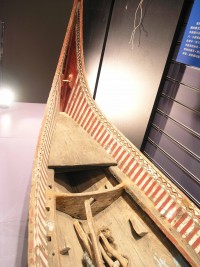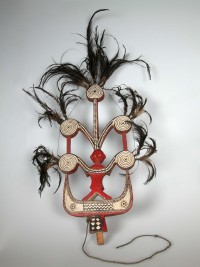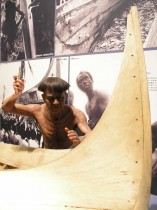TELDAP Collections
| Yami Traditional Fishing Boats |
|
I. Traditional Dwellings The traditional living and activity area of the Yami included a main house, a workhouse and a free-standing veranda. The main house is semi-subterranean, meaning that the entrance is below ground. This has the benefit of protection against strong winds. Before the foundation is laid, a drainage system is constructed to prevent flooding in heavy rain. The materials used in traditional dwellings include wood, stone, thatch, rattan, bamboo and reeds, etc. Different types of wood were used in different parts of the dwelling, and there were strict practices regarding the collection of timber. For example, when a tree was cut, it had to fall in an eastward or southward direction. The main post and thatch for the roof could only be obtained on an auspicious day and a pig had to be slaughtered as an offering to bless the home.
II. Traditional Fishing Boats Yami traditional fishing boats are not made from a single tree trunk or log, and thus are not canoes. They are made from multiple planks shaped with an ax. These planks are joined together with wooden dowels and rattan. Once the boat is finished, patterns are carved and the boat is painted red, white and black. Chicken feather decorations adorn the bow and stern. There are three main patterns that appear on the hull of the boat:
Traditionally, the Yami used natural materials to paint their boats. The red color came from the red soil of Lanyu (Orchid Island), while white paint was created from the ash of burnt shells. Coal ash from pots was used to make black paint. These materials are not easy to obtain and process. Thus, nowadays ready-made paint has mostly replaced them. Only the boats for which a launching ceremony is planned can be carved with the above patterns and associated rites performed. The shape of the fishing boat remains the same regardless of its size. It is difficult to distinguish the bow from the stern as both feature steep, upward arcs. This design allows for quick, sharp turns, while maintaining stability. If the boat does capsize, it will float on the surface of the water and can be easily positioned upright. III. Men’s Clothing and Accessories The traditional clothing of Yami males consists of a short, collarless vest and loincloth. The vest was decorated with horizontal stripes in white and black or blue. It is interesting to note that it was taboo for clothing to have an odd number of black or blue stripes. Therefore, patterns of 8, 10 or 12 stripes are most commonly seen. However, a small number of males will defy this taboo and wear vests with 11 or 13 stripes. During a funeral for a blood relative, women will wear their upper garments inside out, while men will usually place a large piece of cloth, reverse side out, on their head to signify that they are in mourning. On formal occasions, in addition to the vest and loincloth, males will carry a long knife. Other accessories include a conical silver helmet, chest ornaments with flattened gold pieces or wood pieces, and silver bracelets. IV. Flying Fish The Yami divide the year into three seasons. The first is called rayon in the Yami language and is flying fish season. This is equivalent to spring and lasts from February to May. The next is teyteyka which means the end of the season in which flying fish can be caught on the surface of the ocean and is equivalent to summer, lasting from June to October. The third is amyan which refers to the season of waiting for the flying fish to return. This is equivalent to winter and lasts from November to January. During rayon (the flying fish season), the males of the tribe catch fish for ceremonial use. During the remaining two seasons, the fish that are caught are not used in any ceremonies. According to the season, there are differences in the type of fish that are caught and the procedures and methods for cooking them. Many of the ceremonies of the Yami are based on the teachings of the legendary “black-winged flying fish king”.
V. Boat Launching Ceremony Yami traditional fishing boats display carved geometric patterns and patterns that are not carved. For boats with carved patterns, the boat owner (usually a skilled boat builder) will hold a large launching ceremony during the summer following completion of the boat building process, which is carried out in front of his home. Boats that do not possess carved patterns are usually built in winter inside boathouses along the shore and are launched without a ceremony. To build a traditional fishing boat with carved patterns may require three years of preparation. For example, in the month following the end of flying fish season, the boat owner raises pigs and goats and prepares new paddies for cultivation.
|
























